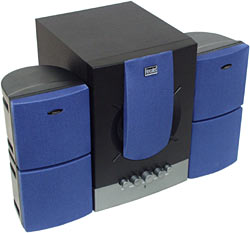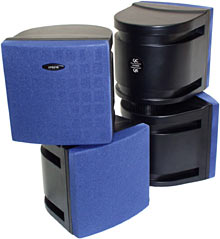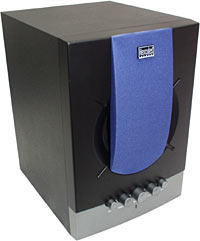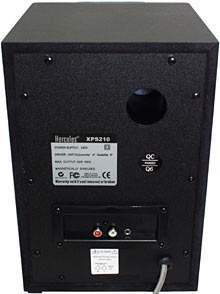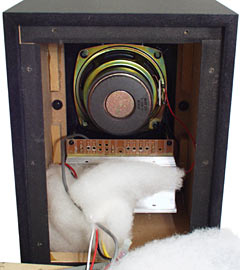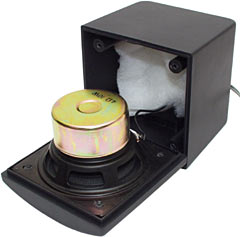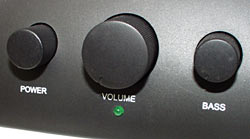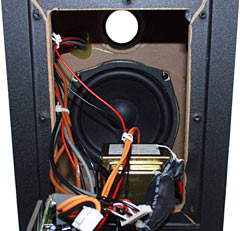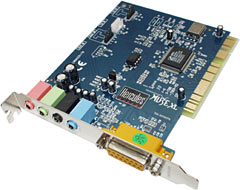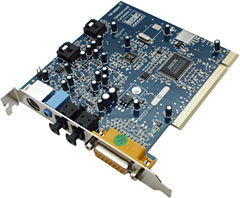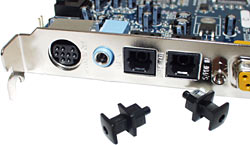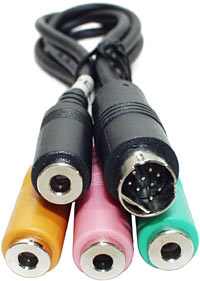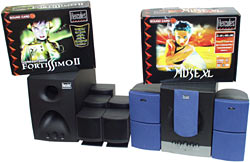
Hercules XPS 210 and 510 speakers, and Gamesurround Muse XL and Fortissimo II sound cards
Review date: 8 March 2002.
Last modified
03-Dec-2011.
Want a good, cheap, set of computer speakers? Want a good, cheap, sound card to match?
Fair enough.
Hercules have filled this niche pretty well, with two of their "XPS" multimedia speaker systems, and two of their "Gamesurround" sound cards. There's nothing about these products that means you have to buy them together, but each speaker set is quite nicely matched by one of the sound cards. If you're looking for a simple and cost-effective audio upgrade for your computer, or a decent combo to install in a new machine, one of these pairs could be just what you want.
First, though, Dan's Philosophy On Computer Speakers. It is as follows:
Computer speaker systems should be cheap.
Apart from the fact that it's nice when things you want don't cost much, the reason why computer speakers should be cheap is because the ones that aren't cheap end up competing with much more serious audio gear. And that's not a competition that little "multimedia speakers" are likely to win.
Take a set of half-decent "bookshelf" hi-fi speakers and plug them into a basic integrated amplifier, and you've got a stereo sound system that only the best multimedia speakers can beat. Now, a multimedia speaker system may have surround speakers and a centre channel speaker as well, but you can do that with cheap hi-fi gear too. There are plenty of perfectly good surround amplifiers on the second hand market, brand new entry level multi-channel amps aren't that expensive, either, and then all you need are three more speakers.
For this reason, if a computer speaker system costs the thick end of $AU1000 ($US500 or so), then second hand "proper" hi-fi gear is likely to be a better deal.
Subwoofer/satellite multimedia speaker sets, you see, are generally built for looks and compactness, not sound quality. The "subwoofer" in most of them isn't actually very "sub" at all, since it's very likely to have a small vented cabinet the size of a couple of stacked shoeboxes, containing a six inch or smaller bass driver. The subwoofer will have a big lump in its low frequency response, in the bass-drum/game-explosion-noise region, but that'll make the bass in general a muddy mess, and won't change the fact that a little bass driver will give you no real low bass at all.
Ordinary floor-standing hi-fi speakers with six inch or larger bass drivers, plugged into any old second hand amplifier, will absolutely dung all over the bass response of pretty much any multimedia speaker system.
If you're playing games and just want absolute maximum floorboard movement, never mind about the accuracy, then there are a few multimedia speaker systems that do very well indeed. Like, for instance, the Logitech Z-560 setup I review here. But, generally speaking, multimedia speakers have crummy bass response, especially for music, when you want to hear the low-pitched instruments, not just a vague rumble.
The midrange and treble performance of PC speakers is generally nothing to write home about, either, because the satellite speakers usually have a single dinky little driver in a plastic box of no particular merit. These "widerange" drivers aren't likely to actually have a very wide range, which means the subwoofer often has to play a fair bit of low midrange to fill the response gap. And the little satellite boxes generally contribute considerable resonance effects.
On the plus side, multimedia speaker satellites are small and will fit pretty much anywhere. But they don't sound great. You don't need to be a golden-eared audiophile to hear the difference between a PC speaker rig and practically any real hi-fi speaker.
So that's why PC speaker systems should be cheap. Their price niche should be well below any decent new hi-fi gear, and more than competitive with OK used stuff. Otherwise, they're just not a good buy.
Case in point - Creative Labs' flagship Inspire Digital 5700 speaker system, which I also check out in the abovementioned article. Despite its high price, the 5700's sound quality is quite underwhelming. It's got all sorts of surround decoding abilities, but I'd prefer to spend the same money on a better sounding plain stereo hi-fi system, even for computer use and movie viewing - good sound from in front of you beats lousy sound all around. The 5700's actually not a lot less expensive than a proper entry level surround system. It needs to be half the price, to compete properly.
Hercules' XPS 210 and XPS 510 speaker systems, on the other hand, pass the cheapness test. They're not real bargain basement systems, but they're not far from it. The XPS 210 is currently $AU132, delivered, from Aus PC Market; the XPS 510 is $AU184.80 delivered.
The model numbers tell you the kinds of speakers these are. The XPS 210 is a "2.1" channel system with two satellites and a subwoofer, while the XPS 510 is a "5.1" channel setup, with five satellites (right, left, centre, right surround, left surround) and a sub.
First, the cheaper ones.
XPS 210
This is a good looking speaker system. Matching blue cloth grilles on the subwoofer and satellites, and a bit of silver plastic trim on the sub, but no outrageous air dams or bas-reliefs. It's good that the grilles look OK, mind you, because you can't remove them.
The XPS 210 satellites are obviously, um, "inspired" by Bose's smaller and more expensive Lifestyle System satellites. The top of the 210 satellite speaker contains a small cone tweeter, and it can be turned 45 degrees to the left or right relative to the bottom, which contains a three inch widerange driver.
I don't know what the XPS 210 satellites look like on the inside, though, because they're factory-sealed, and I didn't feel like sawing one open. There's a pop-out plug on the bottom of the satellites, though, which reveals a simple 5/16 inch hole in the bottom of the cabinet. This is presumably so that you can mount them on a stand.
The XPS 210 satellites have 1.8 metre (six foot) cables, so you shouldn't have any trouble getting them set up.
The XPS 210 subwoofer contains the control and amplifier electronics, and also has all of the knobs and buttons. This is less than totally convenient, since the sub will probably be sitting under your desk or in some other hard to reach spot. You could get the hang of pressing the power button with your toe, I suppose.
The biggest knob on the sub is for bass, not volume, which may be a statement about these speakers' target market. There's a treble knob, too.
The controls on either end of the row are buttons, not knobs; the power button's on the right, and there's a "3D" button on the left. That activates a stereo expansion processor, of which more later.
The only real problem with these controls is that they're too close together. The whole button row is les than 9cm (3.5 inches) long, so you can't grab any of the three knobs and turn it all the way - the other ones get in the way of your fingers.
The back of the XPS 210 subwoofer contains the minimalist inputs and outputs - one 1/8th inch stereo jack for input, two RCA connectors for speaker output, and that's it.
RCA plugs are commonly used as connectors for small speakers; they're not really made for it, but they work fine for low power audio. They also make it impossible for the user to get the positive and negative wires backwards on one or more satellites, and then wonder why things sound weird.
Unscrew the electronics-module back panel of the 210 sub and you find a few good things.
One, the back panel is a tight fit and has a rubber gasket. Even dirt cheap PC speaker systems usually don't have leaky subwoofer cabinets, but if one does, you may find yourself blessed with a whistling subwoofer. Not here.
Two, the inside of the sub has little bracing blocks glued into the joins between the panels. This makes the box more rigid, which is important for reducing resonance. Making the box out of a non-resonant material also helps; this sub's made out of high density particle board, not plastic. This isn't a special feature, though; lots of very cheap sub-sat systems now have corner-braced wooden subs.
Three, there's some polyester fibre wadding - the white fluffy stuff - in there.
BAF is the standard middle-of-the-road speaker lagging material, used to break up cabinet resonances and make the box acoustically bigger, at the expense of efficiency. The lagging can also, in a powered speaker box like this, prevent wires from buzzing against other things inside the box.
Many computer speakers have no lagging in them at all, which makes them more efficient (louder for a given power input), but also makes them more resonant, which is bad. BAF doesn't settle, come to bits, rot or burn, and it's not terribly expensive either. It's not the best acoustic absorber ever, but it's got a good combination of other qualities.
In case you're wondering what else might have been in there, besides nothing, there's only one plausible alternative - a wad of random cotton fibres. Various really cheap speakers contain cotton fibre lagging; it's very inexpensive indeed, but it'll settle into a puddle in the bottom of the speaker over time.
There are lots of other lagging materials - wool, bituminous pads, exotic fibres - but you won't find any of them in cheap speakers. What you might find, but thankfully almost definitely won't, is glass fibre, like the stuff roof insulation batts are made of. This is worth mentioning, if you're considering hitting the garage sales to find yourself some big cheap speakers for computer use, because there's glass fibre lagging inside a disturbing number of 1970s speakers. If they're ported, they can spit glass dust into the room when you turn 'em up loud. You probably won't get mesothelioma from 'em - certainly not if they've got a sealed box with no port - but you should still wear gloves and a face mask if you open the box.
Fortunately, I don't think anybody uses that stuff any more.
Anyway, there's a patch of lagging wrapped around the wiring inside the XPS 210 sub box, and another one attached to the rear panel assembly, covering the power transformer and the interior opening of the small rear port. The lagging over the port is a good thing; it helps to reduce "chuffing" noises when a lot of air's moving through the tube, as it will be whenever the sub's working hard.
Peering into the XPS 210 sub, you can see the back of the four inch bass driver. The ring magnet on the back of the driver's pole piece is there for magnetic shielding; it's aligned in opposition to the driver's own voice coil magnet, and the result is a much smaller radiated field, so you can put this sub close to a computer monitor without distorting the image. The XPS 210 satellites are shielded, too.
The sticker on the back of the sub rates the XPS 210 as having a total power output of 30 watts RMS, which is perfectly plausible, and perfectly acceptable. Since sound volume increases with the square of the power, three watts is half as loud as 30, which is half as loud as 300, all things being equal. How much noise you get per watt depends on the efficiency of the speakers, but unless your speakers are unusually inefficient, you won't be using more than five watts RMS total, for normal listening.
Hercules seem to describe this as a 50 watt system in their on-line specs listings, but it really doesn't matter. 30 watts is plenty for computer speakers.
I'll get to what the XPS 210 actually sounds like in a moment. First, its big brother.
XPS 510
The XPS 510 system looks less interesting than the 210, assuming you're not excited by those three extra satellites.
The sats are tiddly little cubic-box three-inch-driver units, pretty much like the sats that come with various other multimedia speakers. Their angled stands are removable, and there's a keyhole slot in the back of each satellite to allow you to hang it on the wall if you like, but that's it.
The three front satellites have three metre cables; the two rear satellites have six metre ones. Apart from that, they're all exactly the same.
Inside the satellites is another scrap of BAF, and a magnetically shielded three inch driver of no particular merit. These drivers have the same dual-magnet arrangement as the XPS 210 subwoofer driver, but they hide it under a metal cap, like most magnetically shielded speakers.
The XPS 510 subwoofer has a mild case of Useless Cosmetic Air Dam Disease. The big sculpted ducty thing on the bottom of the front panel is just a decoration; it doesn't lead to a hole in the case. The port at the top of the front panel is real, though; this is a "bandpass" enclosure, which doesn't let you see the actual bass driver.
The 510 has very basic controls - power, volume, bass, and that's it. Not even a treble knob. Since the controls are on the sub, you'll probably once again either be leaving these speakers on all the time, or learning to operate the power button with your foot.
The back of the subwoofer makes up for the minimalist front. There are five RCA outputs for the five satellites, and there are three 1/8th inch stereo inputs. These inputs have the usual arrangement - one for front left and right, one for surround left and right, one for front centre and subwoofer. You don't have to have something connected to the subwoofer input in order to use it; if only the front stereo input's in use, the sub will work anyway. There's no way to double up the other channels, though, so if you want anything from the surround or centre speakers, you'll need a real signal going to that input.
There XPS 510 also has a nine pin mini-DIN "G9" input, which is a reasonably well known format that lets you connect all of the channels up with one cable. The G9 input is still analogue, though, not digital; the XPS 510 has no surround decoding features. But it does come with three 1/8th inch leads and a G9 cable, which is nice.
Unscrew the back of the XPS 510 and you have to unplug a few wires (and undo a twist-tie, and remove a nylon cable tie) before you can hinge down the back panel. The electronics module in the 510 is more substantial than the one in the 210, as you'd expect, but Hercules still don't make grand power output claims; they say 60 watts total (20 watt subwoofer, eight watts per satellite).
The 510 subwoofer's as well sealed as the 210 one, but there's no lagging in it. Well, not in this rear chamber, anyway; bandpass boxes like this one have one ported chamber and one sealed one, separated by a divider panel in the middle of the box.
Inside the 510 sub you can see the five-and-a-bit-inch driver, which fires backwards into this rear ported chamber. The white circle at the top is the port, which passes through the sealed front chamber on its way to the front panel.
I didn't have the energy to dismount the transformer inside the 510 sub; I would have had to, if I wanted to remove the driver and look at the back of it. Since there aren't any suspiciously high power output claims being made here, there's no reason to pry further.
Listening tests
I wasn't overly optimistic about the sound quality I'd get from the Hercules speakers. I was pleasantly surprised.
The 210 satellites sound pretty good. Better than the usual single-driver tiny-box satellites, that's for sure. The swivel-top design lets you fool around with the satellites' dispersion pattern; if you enjoy tweaking, you'll probably derive considerable entertainment from seeing what satellite arrangement works the best, with and without the "3D" button pressed.
The 3D effect is quite pleasing. 3D expanders used to be nasty analogue devices that made crummy speakers sitting very close together sound like... well, like really crummy speakers, facing the wall, fed through a messed-up graphic equaliser, but, yes, further apart.
Nowadays, stereo expanders use funky digital signal processing tricks to widen the soundstage without assaulting the sound too badly; they don't help you realise a pin-sharp stereo image, but they're perfectly acceptable for most listening material, and they're great if you want a big airy sound from satellite speakers sitting on your desk.
The most significant thing about the XPS210 system, though, is that its sub really is a sub. Well, not a proper low-bass-only subwoofer; you can only get so much from a four inch driver. But at least it's not a midrange speaker.
The filter that feeds this subwoofer genuinely does block everything above the bass register, so you don't hear the sub contributing to, say, the cello parts in classical music. Some subs have to do that because their satellites need the help. Some subs do it because they've got a lousy crossover. This one doesn't even do it if you put your ear to the subwoofer driver. Unplug the satellites and everything but the bass disappears.
As a result of this, the XPS 210 subwoofer won't announce its location. You can, therefore, actually listen to music on this system and get a genuinely good stereo image. An audiophile's delight it ain't, but it's a big step up from most computer speaker systems.
The thing's not magic, mind you. The XPS 210 sub still gives you the usual choice of not very much bass, if you set the bass knob to the 12 o'clock mark, or a hollow resonant mid-bass mess if you wind the bass all the way up. It's got as much bass response as you can expect from a cheap-ish computer speaker sub; there's some bass, but nothing much below about 90 Hertz. There's also a pretty hefty in-room response hump around the 130Hz mark, which shows up quite prominently when there's some distinct component of the input signal with plenty of energy around that frequency - timpani in an orchestral piece, for instance.
With sensible bass settings, the XPS210 system can play as loud as any sane person will want a computer speaker system to go. And what bass there is, is not too bad; the no-midrange sub might not knock the dust off your monitor, but it'll vibrate your kidneys a little bit.
For the money, the XPS 210 system turns in an excellent performance.
The XPS 510 sounds better than the XPS 210, for surround sources. Because, um, it's got surround speakers.
Since there's no simple stereo-through-all-speakers button on the XPS 510, though, you must connect it to a true five channel source if you want all five satellites to make a noise. The sub works even if you've only connected a single stereo input, but the surround and centre speakers won't.
The 510 satellites aren't a sonic revelation, but they're not awful. I suspect the 210s use the same widerange driver as the 510, but the 210 sats have a separate tweeter as well, which does make a difference. The 210 has that stereo expander button, too; the 510 doesn't.
The XPS 510 subwoofer has a similar in-room response hump to the 210 one, but it's got noticeably superior bass extension, only dribbling away to nothing below about 55Hz. It's not a loud bass producer over the 60 to 90Hz range, but at least there's something there.
The 510 sub has the same solid no-midrange filter as the 210 sub, which is good, for the same reasons. The 510 satellites don't have the same treble clarity as the 210 ones, but their midrange performance seems much the same, so they don't need any more midrange support than the twin-driver 210 units.
For plain stereo music, the 510 wins narrowly if you want bass, and the 210 wins narrowly if you want anything else. For surround, the 510 obviously wins, but it'd still be nice if it came with the same satellites as the 210. Even if it came with only three of them, for the front channels; swapping the 210 satellites into the 510's front left and right outputs significantly improved it.
Once again, though, this isn't a bad product, considering its price. Its sub's stronger than average, its satellites are no worse than average, and it's not expensive.
And now...
The sound cards
Hercules have set themselves up as a worthy competitor to Creative in the consumer sound card market, particularly recently. Creative's less-than-brilliant software team still don't seem to have achieved complete fecal cohesion, and various motherboards have turned out to have... issues... with Creative's current cards.
Hercules, like Creative, have sound card models from entry level to deluxe. I checked out their monster Game Theater XP here a while ago, but most people don't need a connector-encrusted external box hooked up to their sound card by a cable. Most people just want a good cheap card that works.
Accordingly, here are the two cheapest Hercules cards at the moment, the Gamesurround Muse XL and Gamesurround Fortissimo II.
The Muse XL has four speaker output, via two 1/8th inch stereo jacks, plus the usual mic-in, line-in and joystick/MIDI connectors. So it matches the XPS 210 speaker system just fine, but can also drive a basic surround setup, if you like.
And it's blue.
The price, though, is the real news - the Muse XL is currently selling for a big $AU49.50 at Aus PC Market, including delivery. You can get cheaper sound cards than this, but not much cheaper.
The Muse XL's driven by the popular C-Media CMI-8738 chip, which you'll also find on various integrated-audio motherboards. This chip uses Sensaura positional audio technology, which gives it compatibility with the usual list of Microsoft and Creative 3D sound APIs, and makes it a perfectly OK choice for two or four speaker game playing. Note that for really good 3D sound, it's a better idea to use headphones than multiple speakers.
There's not a lot more you can say about the Muse XL hardware, except that it's likely to work well with any PC that's got a PCI slot to accept it. The C-Media chip doesn't have any major compatibility issues that I know of, and its drivers are mature. This may be a cheap sound card, but it's not a nasty one.
The Gamesurround Fortissimo II is fancier, but not a great deal more expensive. It sells for only $AU115.50, delivered.
It, also, is blue.
For your extra money, you get several more connectors. There's a DIN connector into which you can plug a supplied breakout cable - see below. There's also a stereo line in, and then there are two optical S/PDIF connectors - one in, one out.
So not only can you connect the output of the Fortissimo II to your fancy home theatre amplifier, MiniDisc recorder, DAT deck or what have you, but you can also record S/PDIF digital audio from outside.
Dual S/PDIF connectors aren't an amazing new feature that you can't find anywhere else, but they're pretty darn impressive on a sound card this cheap.
There's also, of course, a gameport/MIDI connector.
The DIN connector on the back of the Fortissimo II looks the same as the one-wire G9 5.1 channel connector on the back of the XPS 510 kit, but it's not; the pinout is different, and there are only four channels.
You can, instead, plug this supplied breakout cable into the socket on the Fortissimo II, and get standard 1/8th inch stereo jacks for mic in, headphone out, and front and rear speaker out.
The Fortissimo II is powered by a Cirrus Logic CS4624, another popular commodity audio chip with Sensaura support which, again, supports the usual laundry list of 3D sound APIs. The Cirrus chip also understands Dolby Digital (AC-3), which allows this card to integrate with popular DVD playback packages to give you proper surround sound output from your DVD movies.
The bundle
The two Gamesurrounds I got for review are "OEM" cards, but they don't look it. They come in a full show-off retail box, instead of the simple white box or mere anti-static bag that most OEM gear has.
You don't actually lose out on much because of this, though. You still get a quality paper manual, which is replicated in HTML form on the single included CD-ROM. It's rather refreshing to have a properly done HTML manual instead of the usual straight-from-the-DTP-software Adobe Acrobat versions that most hardware comes with these days.
When you're installing the cards, don't use the drivers from the CD; they're old. Go to the Hercules support page and download the latest version instead.
Apart from the slightly elderly drivers, the two Gamesurround CDs are very similar, and neither of them are particularly exciting.
The Muse XL disc contains MusicMatch Jukebox 6.0, but it's only the free-to-download version, and you download v7.0 now, so who cares. There's also Sonic Foundry's ACID XPress, but that, too, is a product you can download for free.
You also get Sonic Foundry's Siren Jukebox Xpress, a digital music player and cataloguer sort of thing, but you might as well use Winamp. Sonic Foundry agree with me about this; if you follow Hercules' "get the full version of Siren Jukebox" links, you'll end up on a page that tells you that the product's no longer for sale.
Slightly more usefully, there's Yamaha's XG Player utility, whose main function is to wrap around their software MIDI synthesiser, using the PC CPU to generate better MIDI voices than the sound card itself could manage.
But XG Player is, wait for it, another free-to-download program.
There's also a 30 day trial version of CyberLink's PowerDVD, which won't be any use to you if you don't have a DVD-ROM drive. And which is, whaddayaknow, free to download from CyberLink.
And there's Eatsleepmusic's Kool Karaoke Lite. This may be a very good product, but I have a deep-seated philosophical objection to karaoke, so I'm afraid I can't say any more about it.
There's also Media Station, which is Hercules' contribution to the zillion and one CD player/wave player/MIDI player/mixer combo-applications out there. As is traditional for such programs, Media Station doesn't seem to do anything that the standard Windows sound apps can't; it just puts all of the functions together in one non-standard interface.
The Fortissimo II CD is much the same as the Muse XL one, except there's no PowerDVD demo.
The full retail versions of these cards also come with a special cut-down Hercules version of Arturia's STORM home composition package, and another "special edition" of the Game Commander 2 voice recognition package.
You don't get this gear with the OEM cards, but you wouldn't know it to look at the boxes; they're for the retail version, and proudly claim that all of the retail software is inside, when it isn't.
I presume that the Hercules distributor that provided these cards just bought OEM cards, and retail boxes. Cards and boxes are shipped separately, with the boxes packed flat to save space. This is very unlikely to be the way that Hercules intended to sell these cards.
If you feel like being obnoxious, you could buy these cards and then demand the software that the box promises you. I don't think you'd get it, though - the poor retailer would probably just have to offer you a refund.
If you don't have that sort of personality, just bear in mind that these are the OEM versions, in the wrong box, for some reason. There's no harm done as long as you know what you're getting.
Overall
Folks, this is what the term "cheap and cheerful" is all about.
The XPS 210 looks good, sounds good, and doesn't cost much.
The XPS 510 would be lousy if it were twice the price, but it isn't, so it's great.
The Muse XL is almost alarmingly cheap, but provides all of the sound card features that most people want. If all you need is something that can play a tasteful Duckman sample when your computer starts up, then you can get away with buying something even cheaper. But if you want positional audio capabilities, the Muse XL is where it's at.
The Fortissimo II has as many features as are needed by most people who buy top-of-the-line sound cards with separate connector panels. If you need Maximum Pose Value then you don't need the Fortissimo, but if you want four channel surround outputs (not full 5.1 channel) and optical in and out, then there's really no going past this cheapie.
If money is no object, then you can definitely get better speakers than these, and probably get better sound cards too, depending on what you actually need a sound card to do. But if you've got an eye for a bargain, then there are four of them here.
Recommended.
Hercules Asia's page for the Gamesurround Muse XL
Hercules Asia's page for the Gamesurround Fortissimo II
